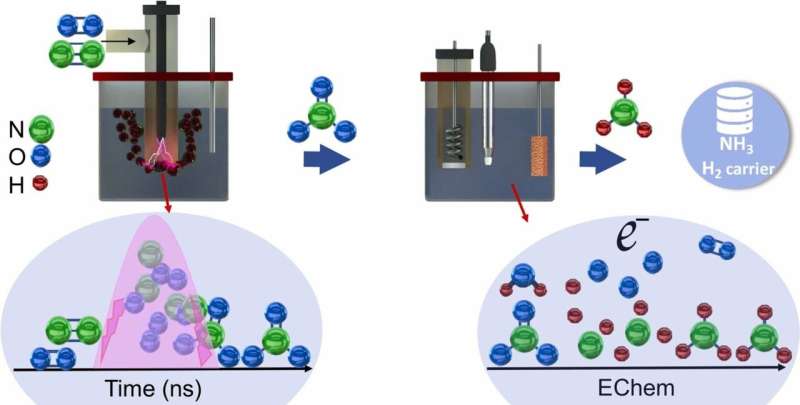This article has been reviewed according to Science X's editorial process and policies. Editors have highlighted the following attributes while ensuring the content's credibility:
fact-checked
trusted source
proofread
Researchers a step closer to making green ammonia a reality

The production of ammonia for fertilizers—which has one of the largest carbon footprints among industrial processes—may soon be possible on farms using low-cost, low-energy and environmentally friendly technology. Researchers at UNSW Sydney and their collaborators have developed an innovative technique for sustainable ammonia production at scale.
Up until now, the production of ammonia has relied on high-energy processes that leave a massive global carbon footprint—temperatures of more than 400 °C and pressures exceeding 200 atmospheres that account for 2% of the world's energy and 1.8% of its CO2.
But the researchers have come up with a method that significantly enhances energy efficiency while making environmentally friendly ammonia economically feasible. The new technique eliminates the requirement for high temperatures, high pressure, and extensive infrastructure in ammonia production.
In a paper published recently in the journal Applied Catalysis B: Environmental, the authors show that the process they developed has enabled the large-scale synthesis of green ammonia by increasing its energy efficiency and production rate.
The foundation of this research, previously published by the same research group, has already been licensed to an Australian industry partner, PlasmaLeap Technologies, through the UNSW Knowledge Exchange program. It is set to be translated into the Australian agriculture industry, with a prototype already scaled up and ready for deployment.
The latest study follows on from the proof-of-concept research performed by the same UNSW research group three years ago with significant advances in energy efficiency and production rate in the process, thus improving commercial profitability.
The research also represents an opportunity to use green ammonia in the hydrogen transport market, as liquid ammonia (NH3) can store more hydrogen in a smaller space than liquefied hydrogen (H2), making the transportation of hydrogen energy more economical.
Net zero objectives
While the conventional process used for ammonia production is notably energy-intensive—relying heavily on fossil fuels as its primary energy and hydrogen sources—it has been instrumental in increasing crop yields and sustaining a growing global population.
Dr. Ali Jalili, the study's leader and a former Australian Research Council DECRA Fellow at UNSW, says adopting a sustainable approach to ammonia production is crucial for global net zero objectives.
"Currently, the traditional method of producing ammonia—known as the Haber-Bosch process—accounts for 2.4 tonnes of CO2 per tonne of ammonia, equivalent to approximately 2% of global carbon emissions. Additionally, Haber-Bosch is economically viable only in large-scale and centralized facilities. Consequently, the transportation from these facilities to farms will increase the CO2 emission by 50%," he says.
"Ammonia-based fertilizers are in critically short supply due to international supply chain disruptions and geopolitical issues, which impact our food security and production costs.
"This, together with its potential for hydrogen energy storage and transportation, makes ammonia key to Australia's renewable energy initiatives, positioning the country among the leaders in renewable energy exports and utilization."
As well as addressing economic and logistical challenges associated with intermittent energy sources for cities or farms, Dr. Jalili says to fully unlock its potential, it is "essential to establish a decentralized and energy-efficient production method that can effectively use surplus renewable electricity."
More information: Jing Sun et al, Sustainable ammonia production via nanosecond-pulsed plasma oxidation and electrocatalytic reduction, Applied Catalysis B: Environmental (2023). DOI: 10.1016/j.apcatb.2023.123426


















